Click on images to enlarge
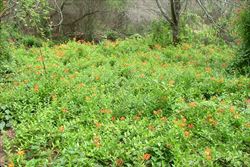
dense infestation (Photo: Sheldon Navie)
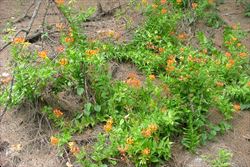
scrambling habit (Photo: Sheldon Navie)

climbing habit (Photo: Sheldon Navie)
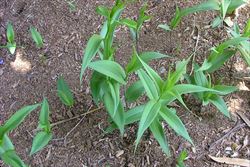
young spring growth from underground tubers (Photo: Sheldon Navie)
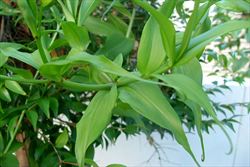
leaves with hooked tendrils (Photo: Sheldon Navie)
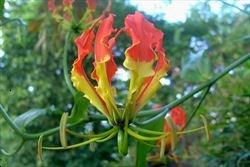
flower (Photo: Sheldon Navie)
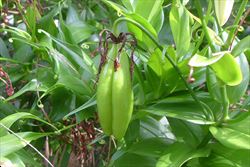
immature fruit (Photo: Sheldon Navie)
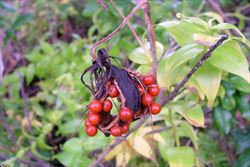
mature fruit with seeds (Photo: Sheldon Navie)

old fruit (Photo: Sheldon Navie)
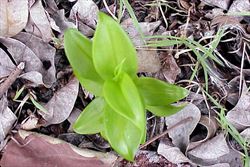
seedling (Photo: Sheldon Navie)
Scientific Name
Gloriosa superba L.
Synonyms
Gloriosa rothschildiana O'Brien
Family
Colchicaceae
Common Names
climbing lily, creeping lily, fire lily, flame lily, gloriosa, gloriosa lily, glory lily, Rhodesian flame lily
Origin
Native to sub-Saharan Africa (i.e. Ethiopia, Somalia, Sudan, Kenya, Tanzania, Uganda, Senegal, Mozambique, Botswana, Namibia, Swaziland, Madagascar and South Africa), the Indian Sub-continent (i.e. India, Nepal and Sri Lanka), southern China and south-eastern Asia (i.e. Cambodia, Laos, Myanmar, Thailand, Vietnam and Indonesia).
Cultivation
Glory lily (Gloriosa superba) has been widely cultivated as a garden ornamental, particularly in the warmer parts of the country. Several cultivars are still common in cultivation, and these are usually distinguished by the colour of their flowers. Cultivars include 'Citrina', 'Grandiflora', 'Rothschildiana' and 'Simplex', with 'Rothschildiana' the most common.
Naturalised Distribution
This species is widely naturalised along the coast of eastern Australia, from northern Queensland through to central New South Wales. It is most common in northern New South Wales and south-eastern Queensland. Also naturalised on Lord Howe Island and Norfolk Island, and sparingly naturalised in the Northern Territory.
Habitat
This species is mostly a weed of sandy coastal environments and offshore islands in tropical, sub-tropical and warmer temperate regions. It is also found growing in and around parks and gardens in coastal districts.
Habit
A long-lived (i.e. perennial) herbaceous climber or creeper that develops a network of creeping underground stems (i.e. rhizomes) and tuberous roots. The short-lived (i.e. annual) aboveground stems grow up to 4 m long and usually die back each winter.
Distinguishing Features
- a scrambling or climbing plant with stems growing up to 4 m long.
- its shiny bright green leaves are alternately arranged, stalkless, and usually have short tendrils (1-2 cm long) at their tips.
- its showy flowers have six large 'petals' (5-8 cm long) that are usually bright red or orange with yellow markings.
- their 'petals' have wavy edges and are strongly turned backwards.
- its fruit are fleshy capsules (3-10 cm long and 1-2 cm wide) containing many large (4-5 mm long), round, reddish seeds.
Stems and Leaves
The stems and leaves are shiny, hairless (i.e. glabrous), and light green or bright green in colour. Stems are upright (i.e. erect) at first then sprawl across the ground, clamber over other vegetation, or climb if a suitable support is within reach.
The leaves are alternately arranged along the stems, stalkless (i.e. sessile), and have entire margins. These leaves (4-25 cm long and 1.5-4.5 cm wide) are relatively narrow (i.e. lanceolate to broadly lanceolate) and usually taper to a short tendril (1-2 cm long) at the tip. These tendrils readily cling to other objects and assists the plant to climb up over vegetation.
Flowers and Fruit
The flowers are large and showy (4.5-7 cm across) with six 'petals' (i.e. perianth segments or tepals) that are red, orange and yellow in colour. These elongated 'petals' (5-8 cm long and 7-15 mm wide) have wavy (i.e. undulating) margins and are strongly bent backwards (i.e. reflexed). They are actually derived from three petals and three sepals which are almost identical in appearance. They are most commonly scarlet red or reddish-orange with yellow bases, and as they age they become entirely dull red or purplish in colour. The flowers also have six very conspicuous stamens, with large anthers (7-10 mm long) that are borne on stalks (i.e. filaments) 3-7 cm long. They also have a large style (3.5-5.5 cm long), which splits into three short branches near its tip. These flowers are borne on stalks (i.e. pedicels) 4-20 cm long that emanate from the upper leaf forks (i.e. axils). Flowering occurs mostly during summer and autumn (i.e. from October to May).
The fruit are large, fleshy, capsules (3-10 cm long and 1-2 cm wide) that turn from green to yellow and eventually dark brown as they mature. These fruit contain numerous large red seeds (4-5 mm long) that are rounded (i.e. globular) or egg-shaped (i.e. ovoid).
Reproduction and Dispersal
This plant reproduces vegetatively by creeping underground stems (i.e. rhizomes) and also by seed.
Its seeds may be dispersed by animals (e.g. birds) that eat its fruit, by water and in contaminated soil. Seeds and stem segments (i.e. rhizomes) may alsoo be spread in dumped garden waste.
Environmental Impact
Glory lily (Gloriosa superba) is regarded as a significant environmental weed in New South Wales and Queensland, and as a potential environmental weed or sleeper weed in other parts of Australia. It is currently of most concern in south-eastern Queensland and north-eastern New South Wales, and is listed as a priority environmental weed in three Natural Resource Management regions in these areas.
Glory lily (Gloriosa superba) forms dense understorey carpets in coastal dune systems and replaces native flora in these areas. It also invades nearby areas of coastal dry sclerophyll forest and littoral rainforest and readily colonises bare soil. Its persistent tubers re-shoot even when the foliage has been removed and these tubers have been recorded in densities of 70-100 per square metre in heavily infested areas.
In south-eastern Queensland, glory lily (Gloriosa superba) was first recorded as being naturalised at Caloundra in 1950. It is now a serious weed on Moreton Island and Fraser Island, and is present all along the south-east Queensland coast. It appears prominently on local environmental weed lists and during a recent study it was ranked among the top 100 most invasive plants in south-eastern Queensland.
This species has also become one of the most serious environmental weeds along the north coast of New South Wales. It is mainly found along the coast north from Hat Head and also appears on several local environmental weed lists in this region (e.g. in Byron, Coffs Harbour and Lismore Shires). Glory lily (Gloriosa superba) is of most concern in this region because it is affecting the integrity of endangered littoral rainforest communities. For example, severe infestations of this species are present in littoral rainforest in Bongil Bongil National Park, south of Coffs Harbour. It is also becoming a concern on the central coast of New South Wales, and is regarded as an "alert weed" in the northern Sydney region.
Glory lily (Gloriosa superba) is also regarded as being invasive on several Pacific islands (e.g. in the Cook Islands, French Polynesia, the Solomon Islands and Kiribati) and is a declared noxious weed on Lord Howe Island.
Other Impacts
This species is considered poisonous to humans, native animals and livestock. Glory lily (Gloriosa superba) is responsible for large number of human poisonings, and even some deaths, in Sri Lanka. The recent deaths of several swamp wallabies (Wallabia bicolor) in northern New South Wales has also been attributed to the ingestion of this species.
Legislation
This species is declared under legislation in the following states and territories:
- New South Wales: Class 3 - a regionally controlled weed. The relevant local control authority must be promptly notified of the presence of this weed and it must be fully and continuously suppressed and destroyed (on Lord Howe Island only).
- Western Australia: Unassessed - this species is declared in other states or territories and is prohibited until assessed via a weed risk assessment (throughout the entire state).
Management
For information on the management of this species see the following resources:
- the Queensland Department of Natural Resources and Mines Poster on this species, which is available online at http://www.dpi.qld.gov.au.
- the New South Wales Department of Primary Industries Weed Alert on this species, which is available online at http://www.dpi.nsw.gov.au.
Similar Species
This is a very distinctive plant, especially when in flower, and is rarely confused with other species.

